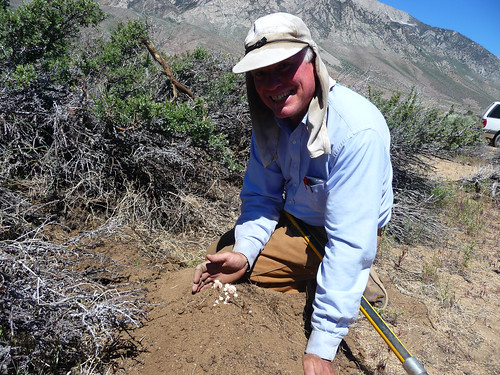
Native American agriculture techniques once dominated the continent, but after the arrival of Europeans, many of those traditions were nearly lost. USDA’s Natural Resources Conservation Service is working with tribal communities and ethnobotanists to restore some of these techniques and crops.
NRCS Earth Team volunteer Ken Lair is working with the Big Pine Paiute Tribe of the Owens Valley in California to test a cultivation technique to stimulate growth of the plant nahavita, or blue dicks.
Traditionally, when native people harvested geophytes through digging, they did more than just retrieve the largest bulbs, corms, tubers and rhizomes for eating—they also replanted the smaller ones so that they could grow into new plants. Lair is testing this cultivation technique by growing nahavita at the Big Pine Indian Reservation.
It has been hypothesized that when the soil around the roots of plants like nahavita is disturbed, the plant population increases in density and vigor. To test the response of nahavita to disturbance, in Lair’s trial some plots will be harvested based on what are thought to be traditional techniques, while others will remain undisturbed for comparison. If the experimental results are consistent with oral tradition, this trial may provide insight into future cultivation of nahavita as a viable food product.
Lair’s test is based on ethnobotanist Kat Anderson’s research. Ethnobotanists study how people of different ethnic backgrounds use plants, and Anderson specializes in Native Americans’ cultural and historical relationship to plants. She also writes culturally significant plant guides for the online NRCS Plants Database, which explain the importance certain plants hold for Native Americans.
Anderson notes an important distinction between the two types of agriculture: Western farmers typically try to maximize yield by growing one crop on a parcel of land and then harvesting everything; Native Americans, however, traditionally often cultivated biologically diverse patches of land and harvested in a manner to meet nutritional, medicinal and material needs.
Lair’s field test with nahavita may help Native Americans recover part of their traditional agriculture. If the traditional cultivation method increases the population density of nahavita, lessons may be learned for its future cultivation, as well as for the cultivation of similar types of plants with bulbs and corms.
NRCS will continue working with tribes to support their efforts to practice traditional agriculture and conservation—and see how these concepts and techniques can improve conservation efforts across the country.
Follow NRCS on Twitter.
Check out other conservation-related stories on the USDA blog.

